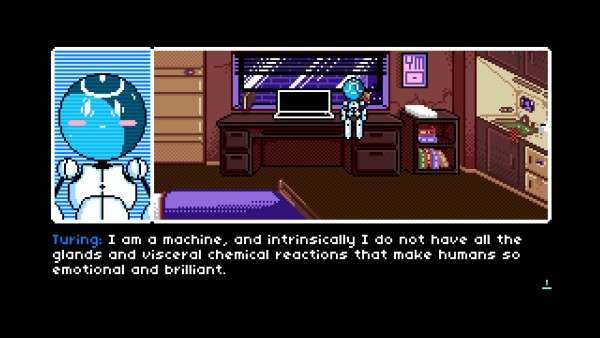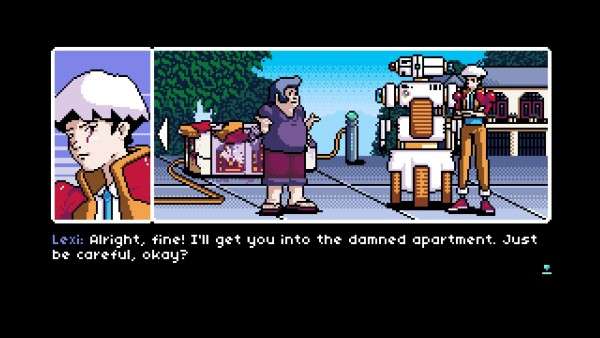
Read Only Memories PC Review
Going into Read Only Memories, I expected the average adventure game trappings that have stuck to the genre over the years. A lot of people have been suggesting that Read Only Memories is the spiritual successor to the SEGA Saturn title Snatcher, that was written and directed by Hideo Kojima back in 1988. Even on the game’s Steam page they say that it was inspired by games like Snatcher. I have never played Snatcher though, in fact I have never been exposed to Snatcher at all despite some interest that I have had in the game. I believe a lot of people are in this same position as well, as the title was on a Saturn and now easily sells for over $300 on sites like ebay, making it not exactly accessible. Due to my inexperience, I was ready for those puzzles that glue you to the ground and laugh while you look for the incredibly specific solution. I assumed that it would be the type of game that I play for a while and come back to, only to still be stuck at the same puzzle I was at before.
So I had a surprising realization about halfway through that this game is an especially different experience from the average adventure game, with more of a focus on player-choice, character development and interaction, and mistakes. If I had to compare Read Only Memories to experiences that I have had in the adventure game genre, I would feel inclined to say that this game is incredibly similar to TellTale’s style of adventure more than anything else I have played. The puzzles are not very difficult, and instead the characters and dialogue choices are the most difficult parts of the game. The world is also well-realized and the game really dives into topics that are going on that could only occur in it’s existence. Comparisons aside, Read Only Memories does things that make it personal and unique from other games in the genre as well.
The developers have a set date and place in mind for the setting of the game: Neo-San Francisco 2064. Which is an interesting choice to make because instead of deciding that the year should go unnamed, something like 20XX, there may be a belief that the events that take place, and the technology that is standard will be feasible by this time in our reality. During this time, there is a conflict of beliefs between two groups of people over the integration of technology in the human biology. There are hybrids, people who utilize technological upgrades to bypass their human limitations, and then there is a movement called #stayhuman who believes that the augmentation of humanity is wrong, and that is corrupts the purity of being a human. Today we have conflicts that parallel this dispute, such as the acceptance of gay, queer and transgender identification, like there is an idea that someone’s choice may create an “adulterated” human race because it doesn’t align with their religion or their personal beliefs. Because of these conflicts, it honestly is not too difficult to think that approximately 40 years from now there will still be problems with accepting different and new changes in society and that it will still hurt people. The thought is incredibly disheartening, that someone in time is always going to be oppressed because they feel and think different than another human being.
A lot of the game’s theme speaks about humanity, whether or not beings that are not humans can retain sapience, and what we really consider to be human-exclusive. For example, one of the struggles that I found in my robotic sidekick Turing was a conflict of greatness. Turing believes in the beginning of the game that he is top of the line and that there has not been anything as technologically advanced as him ever. As he progresses though, he finds that while he is special for some reasons, but there are also a lot of things about him that aren’t very special at all and I found that to be very human. That is just one of the many things that I interpreted from the game’s theme of humanity and sapience though, and I could not list all of them in this review or else I wouldn’t even finish reading it.
The decisions that Read Only Memories gives the player related to the main character was something that I found fascinating. In the beginning of the game you are introduced to the main character through interacting with objects in their musty apartment. An overdue electric bill is in their e-mail stating that they need to pay for their balance or their power is being shut off, another message from their landlord asks for money, and a pair of headphones are sitting on the desk, waiting to be reviewed for OMG ZOUNDS. The sink is overflowing with an unknown ooze, and there is a plant in the window that the protagonist has been observing which is slowly dying. At this point you have painted a picture in your mind about what this character is, I don’t need to write who I think the main character is to give you a better idea because the cracks of information that haven’t been given have already started to fill in through your imagination. After this point, Read Only Memories bathes in player choice.
There is never many other details about the protagonist that changes what you think about them, instead everything that you think about the character is changed by decisions that you make and the way that you have depicted them. In the first chapter you have to give the main character a name and then you have to decide what they identify as. If you want them to be a he, she, or they then you are given the option to label the main character as any of those things. This is the first big option that really shows that the game has swung it’s open hands in the air and said “You have the wheel, not me.” Alongside this, almost every interaction with characters give you multiple choices that help you embody that character that you have decided the protagonist is.
The dialogue and writing in Read Only Memories are the strongest parts of the game. Along the adventure to find out where Turing’s creator, Hayden, went, there are a lot of varied characters that can change depending on which direction the story goes. There are some characters which are staples such as a hacker named TOMCAT who was friends with Hayden, but a lot of characters seem to have more to say in different paths. For instance, in my playthrough of the game there were two boys on a street that were spray painting a business’ wall with street art, and when I tried to stop them they attempted a getaway. I ended up succeeding in foiling their escape and as the game went on I purposefully made decisions to speak with them and befriend them. By the end of my time with the two characters I found out both of them were a lot more complex than what they originally had me believe.
Sometimes these different paths can go awry though. Similar to TellTale’s games, depending on certain paths you take people can live or die. During the period that I played the game I never had any really-close characters die from a choice that I made, but from the options and decisions that I had to made it is apparent that those alternate resolutions are possible. There are also some light puzzle elements that can change the outcome of a situation as well, but they are never too hard. If you do end up having difficulty though, the game has several save slots that allow for do-overs. These saves also come in handy if you want to see an ending different than the one that you have arrived at, or if somehow you accidentally do something you did not mean to.
While I like a lot of these characters, endings and different paths, the end of Read Only Memories really cuts off a lot of the options that made it so personal in the first place. The last part of the game has parts that are basically labeled as your decisions before the final chapter which would lead a person to believe that the decisions they have to make are going to make huge impacts on the last part of the game. This is not true though, instead, the results from actions that were taken earlier in the game occur and funnel you down a corridor of the choices you have made. I think this would work a lot better if it conveyed that this was the situation I was going into. Mass Effect did this in a couple of right and wrong ways, such as part of your crew dying depending on the choices you made, and it was much better because it didn’t deceive me to believe that I could have saved them in the moment. I wish Read Only Memories was more transparent about some of these closed off decisions towards the end, but I guess at some point the endings had to be limited so the devs had to be more controlling of the pathways taken.
There are also a lot of static pieces of writing in the game that are just plain hilarious as well. One of the things that I really like about the game is how much there is to read depending on what you interact with. I am a huge explorer when it comes to games so I would try to click on every object in the room before I went on to the next one, and I was originally just happy to see that each of the objects had their own written pieces. Then I found out that most objects that are carried in the inventory in the game can interact with almost every object in the game, even if they do not do anything when interacting with each other, and they all have their own writing as well. It isn’t some repeated sentence that says, “That won’t work” or “I wouldn’t do that”. I also found that there are a lot of objects that have continued jokes if they are clicked on repeated times, it was nice to see so much detail put into the game. There is also a lot of really good sound design in the game that tells the player when something is bad, good, or even if there is something that may need to be remembered later. It was a subtle part of the game that I really appreciated once I noticed.
Read Only Memories has patched itself through and into my brain unlike a lot of other games this year. There are a lot of thought provoking ideas about topics that have made me think differently about things that I interact with daily like technology, xenophobia, humanity and time. The story and characters are written so well that when I think about the other endings I may have missed I want to go back and play again so I can see what else happens. It even has me thinking about the way that we treat players’ thoughts about characters and how that isn’t something that we should ignore. The gameplay elements of the game are never too difficult, which I think may make some of the game a bit monotonous for those who do not like to read too much during a game. The rest of the elements such as player choice, themes and story are the real pull though and if those sound appealing then this isn’t a game to miss.




